Chapter 8. Navigating Toward the Next-Generation Computer Lab
What should Emory University do with its decade-old computer lab? That question hung in the air for the design team in 2002 as they considered a slate of options for the space that had been the primary undergraduate computing facility on campus. What about an update, provisioning it with newer hardware? How about rearranging it, outfitting the space with different furniture? Maybe they should staff it differently, orienting the facility around a changed support approach? As the design team looked at the facility, these questions and their answers seemed too simple and superficial. The Computing Center at Cox Hall was in crisis.
A once state-of-the-art facility had slowly slipped into disuse, losing the centrality of purpose that prompted its creation in 1991. Increasingly, students arrived on campus with their own personal computers, and a new computing area called the InfoCommons provided well over 200 new workstations to support students and their work. The Computing Center at Cox Hall (see Figure 1) had become a hideout for a certain type of computer user—gamers who holed up in the walled-off cubes that defined the space, playing into the wee hours. Gaming was not the reason the university supported the facility with round-the-clock staffing, nor did it require prime real estate at the center of the campus.
Figure 1. Original Cox Hall with Many Cubicles
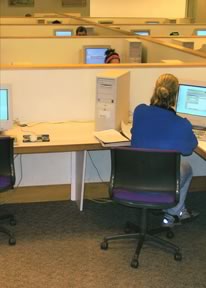
Against this backdrop the project team began a different line of inquiry, a different approach to renovation, which reoriented the computing lab. A description of the players and the thinking that effected that reorientation follows, as well as four principles that informed the team's work. This chapter tells the story of Emory's effort to build a collaborative computing lab, relying on team members who might not always participate in a traditional computing lab design team. Finally, it reflects on the importance of informal learning spaces on today's college and university campuses, bridging the bricks-and-mortar and digital worlds that today's faculty and students both live in.
Informal Learning Spaces
What are informal learning spaces? In Educating the Net Generation,1 Malcolm Brown defined them as "those outside the classrooms." He observed that in a world where wireless connectivity is increasingly ubiquitous, and with wireless devices that enable navigating a proverbial sea of digital resources, practically anywhere but the classroom is an informal learning space. The majority of space on any wirelessly networked college or university campus is informal learning space. On campuses not fully wirelessly enabled, the preponderance of informal learning spaces still exists, but the potential for them to be recognized and "activated" depends on the disposition of the digital learners and the tasks they wish to accomplish.
More abstractly, informal learning spaces are those in which learners live and learn at their discretion. They choose the time and the place to address the work that flows from formal learning spaces and into their lives as homework, projects, ideas to mull over, and conversations to have. That the relationship between formal and informal learning spaces has not received the deliberate attention of campus planners underscores the largely uncoordinated nature of the digital campus's emergence on the brick-and-mortar campus. In this environment, learners choose the locations where they feel most empowered—and most comfortable—to complete the work at hand. In places they see the best support for their way of working, they feel safe and so return frequently, knowing they can move through material and concepts on their terms. In places where they feel discomfort, a lack of connection to space and infrastructure, they leave.
The Case for Change
In late 2001, the Computing Center at Cox Hall—a prime informal learning space—did not complement the formal learning spaces of the university. It seemed unconnected to either the digital world or to the brick-and-mortar world that surrounded and informed it. Our first step was to recognize that a simple redesign would not suffice—we had to acknowledge that the very concept of a general-purpose computing lab was in question. Before the project team even formed, we communicated to the student community that the lab would not receive routine upgrades and maintenance while the university considered fundamental changes. This initial communication, however slight it may sound, was actually quite critical because it paved the way for the lab's audience to understand the seriousness of the effort to rethink the facility. This, in turn, prompted a much more responsive and interested user community when end-user surveys asked questions about the lab's future and desired use. A small, simple public commitment to dialogue and reassessment laid the foundation for broad community input.
Within Emory's Information Technology Division, we had known this day of reckoning for the Computing Center at Cox Hall was looming. In preparation, we had begun talking about those things the facility was not doing: supporting academic work, group work, or faculty and students. What the lab was doing, and with a good degree of success, was supporting the cocurricular lives of students who saw online gaming and chatting with far-away friends as key functions of the facility. As those of us responsible for the lab looked at its function, and what it would take to invigorate the facility with new academic purpose, we investigated facilities on other campuses that spoke to the idea of a next-generation computing lab. The one facility we heard about repeatedly was the USITE/Crerar Computing Center and Cybercafé at the University of Chicago (see chapter 40).
The computing lab support group, who would later form the core of the technical members of the project team, joined our vice provost on a trip to Crerar in December 2001. The trip was significant for a number of reasons. First, Crerar demonstrated the computing lab as a facility that featured different types of spaces—for individual work, group work, class work, and distance work. This hybrid model suggested a degree of flexibility and adaptability missing from Cox. Second, the visit allowed a first-hand view of the impact of food services, in this case a cyber café, on the computing lab's atmosphere. As we sat there and drank our coffee, the facility had less feel of a computing center than Cox, and we saw students sit down to work after fixing the environment to their liking. Finally, Crerar aimed—at least in some locations—to support group work. With the diner-type tables and surrounding banquettes, a group of students could sit and work in the type of space that a cubicle-centric lab like Cox inherently thwarted.
The Team
Soon after this visit the project team formed, in early 2002. Building off the lab manager group, who actually owned the facility and had made the initial trip to Chicago, the team added representation from three other groups: the classroom technologies team, the faculty support team, and the Facilities Management Division's Design Studio. The choice to include classroom technologies representatives was straightforward; those responsible for group viewing and presentation in formal learning spaces would surely have something to contribute to support group work within informal learning spaces. The faculty support team, which brought a perspective from both within the division and directly from the dean's office, could inquire how the facility might increase its role in the academic life of students and faculty. Finally, representatives from the Design Studio initially participated in the selection of an architect; as the project moved from concept to construction, they assisted the architect with the overall look and feel of the space.
Moments arise when, looking back, project planners can identify quasi-unplanned developments that benefited the project (and inevitably, some that did not). The addition of the Design Studio's talented designers was one of those developments whose impact is hard to overemphasize. Their engagement and commitment to the color, texture, and lighting of the space—what many have called the character of the Computing Center at Cox Hall—exceeded the knowledge and abilities of the technologists on the team. To many who have heard the composition of the Cox Hall project team, the question often arises how such a diverse group was assembled in the service of reimagining a lab. From those involved in the project, the real question was, with a facility that had so lost its way, could a strategy be designed that saved a role for the general computing lab on a rapidly changing, space-starved campus?
Grounding Principles
When the project team convened, a number of facts structured our dialogue with the architecture team from Collins, Cooper, and Carusi, our Atlanta-based partners in renovating Cox. Most importantly, the Computing Center at Cox Hall was no longer the only option for students seeking computing resources—they could choose from among their personal desktops and laptops, residential and departmental computing labs, and the InfoCommons. We needed not just a renovation of the facility but a reconceptualization of the lab as one node of computing amongst many spread out across campus.
Design for Uniqueness
This realization gave rise to our first design principle: our renovated facility should be shaped by an awareness of the strengths and weakness of the facilities and capabilities around it. In our particular instance, an installation like the InfoCommons dwarfed the computing resources in Cox Hall and clearly provided general computing space. Should we compete against it? That was never a question for the project team. Should we ask what it does well and what it could do better? This question was central as we looked at the InfoCommons and other computing resources across campus, devising a conceptual map of what spaces supported what types of work.
This principle manifested itself in three architectural requirements. First, the renovation must support group work. As the project team inventoried campus facilities and observed students crowding around individual workstations with inadequate space and infrastructure to support their learning materials and their learning partners, the goal of supporting collaborative work came to the fore. Support for collaboration prompted the second requirement: the facility had to accommodate noise, even encourage it, since conversation is a foundation of collaboration. Third, the facility should address user comfort in ways that none of the inventoried facilities did. This commitment to comfort-oriented furniture and seating selection, as well as allowing food and drink in the facility, was something not permitted at any other institutional computing resource across campus.
Focus on Transparency
Our first design principle, that Cox existed in a physically as well as digitally proscribed context, gave rise to our second design principle: since it exists in a context, that context needed to be clear and navigable to every user. As we spoke to our architecture team, this requirement came across as "the need for transparency." What does this mean? For the project team, it meant a number of things. Students needed to understand the purpose and place of the renovated Computing Center at Cox Hall. They needed to understand the relationship between our formal and informal learning spaces and the connections—designed and serendipitous-between our facilities. A successful renovation, the project team thought, should demonstrate awareness of students and faculty moving throughout the campus, using resources and infrastructure optimized for a specific use. In Cox Hall, that use was the space and infrastructure to support group work.
In this sense, transparency became a cue to users that their time and experience navigating a changing campus, amidst ever-changing technologies, was not haphazard and did have intentionality—a map, some deliberateness—that they would feel when they arrived in the lab. Once they started working, the vantage, the view, would underscore their arrival in the right space for the type of work they were doing. They could see others doing the same thing and model a mode of working and engagement never consciously and designedly supported on campus. Transparency was about enabling recognition on multiple levels. (See Figure 2.)
Figure 2. Fishbowl Offers Everyone a View
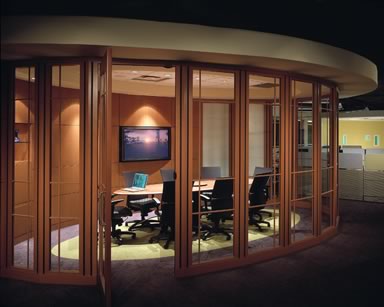
Invite and Encounter
As we reviewed the lab's previous use, it was easy to corroborate the cocurricular activities supported in the facility. More difficult was isolating the curricular, academic activities supported in Cox. That difficulty was unacceptable to the project team and to those who were determining whether the renovation had sufficient merit to fund. From the outset, then, the project team knew they wanted to raise the lab's academic profile. The question became whether to discourage or even eliminate the informal, gaming-type of use within the facility. On this, the project team agreed: The lab was to be a meeting zone, a crossroads between faculty and students, between the curricular and the cocurricular, between work and play—a place of student life. (See Figure 3.)
Figure 3. Large Screens in Lab for Group Work
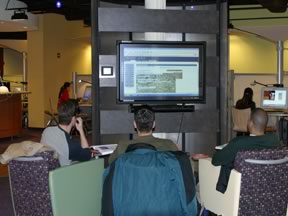
The project team recognized early on that classrooms would be integral to a new conception of the same space, along with paths and venues for connection and crossover, from having coffee with friends while talking about class to sitting at a table and reviewing class material with a professor. It should feel easy to move from one type of use to another. For example, a student might be making a film for a family reunion or working on a documentary for journalism class. The facility would communicate, in its look and feel, that many types of use are acceptable. To the architects and the campus design team, the third principle was clear—the facility was designed to be accommodating on multiple levels, and it should telegraph a message of comfort and suitability at the same time it invites sociability, curiosity, and creativity.
Be Flexible, Be Adaptable
The project team's final design principle grew from the first three and is, in a sense, more overarching then any of the others. To those on the team, it grew from the recognition that we would make mistakes. We were thinking about a computer lab in a way that had few precedents, with no manual to follow or script to copy that would solve our problems. The project team entered unfamiliar territory as the visioning exercise began, and everyone felt we would make mistakes. This awareness fostered a dynamic of collaboration among the team members that channeled trust in wildly interesting ways. For instance, the campus design team recommended workstations where students could recline on large cushions. Mind you, no one had ever seen workstations like this, but the project team decided to give it a try. From the opposite extreme, the technology players, not ordinarily known for their aesthetic or fashion sense, chose from the recommended colors and textures and styles for the lab. Everyone stepped out of their comfort zones, and the project team members respected, even welcomed, incursions that marked true collaboration. As this self-awareness and collaborative working dynamic played itself out before the architecture team, the conclusions became quite simple: Whatever the architects designed, whatever we built, it had to be adaptable.
For the project team and the architect, this became a search for flexibility in everything that would go into the facility. It started with wheels on chairs and tables and progressed to movable walls and whiteboard spaces that could change, adapt, and reinforce the suitability of a location to the work attempted within it, curricular or cocurricular, faculty or student, individual or group. It continued with choosing furniture styles that could hypothetically be reoriented to meet a changing use or need in the lab. (See Figure 4.) Never, the project team vowed, would we wall ourselves into a design that didn't have some humility in the face of the change rippling through our campus and the technologies it offered.
Figure 4. Flexible Technology, Flexible Seating
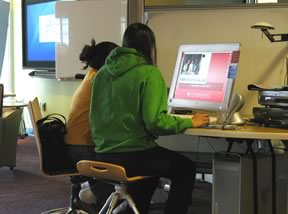
The Way to a New Approach
What started out as an exercise in designing a computer lab and conceptualizing its role on campus became a way of thinking about learning spaces that completely reoriented our approach to facilities. Even that's not quite right, though. In seeing the campus as a network––where students, faculty, and staff constantly step into and out of physical and often digital spaces, sometimes both concurrently––no one on campus had ever indicated to the community any understanding of the navigational challenge posed by the substantial changes that had coursed through the campus in the previous 10 years. The commitment to look at the Computing Center at Cox Hall, and to look at it as deeply, as seriously, as collaboratively as the many players in this renovation did, cleared a path of awareness to exactly this gesture.
In the project's wake, the facility became not only a crossroads on the campus but also a signal in/on the concurrent physical and digital campus that flashed that finding one's way in this changing matrix is navigable if one can see the cues that link the campus together, its buildings to its digital ether. (See Figure 5.) That we realized this navigational approach in an informal learning space—an old, out-of-use lab—as opposed to a formal learning space testifies to the changing place of technology in our culture. For the project team, the lesson was clear: you never know what you'll find unless you begin looking. Sometimes, as with the Computing Center at Cox Hall, you discover a new way of looking.
Figure 5. New Cox Hall: No Cubes, No Walls
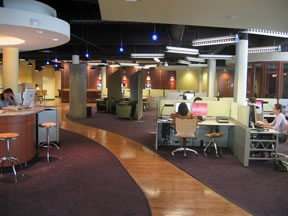
Endnote
- Malcolm Brown, "Learning Spaces," in Educating the Net Generation, Diana G. Oblinger and James L. Oblinger, eds. (Boulder, Colo.: EDUCAUSE, 2005), p. 12.8.
About the Author
Alan R. Cattier is the director of academic technology services at Emory University. He has managed academic technology services for two years and provides coordination and operational management for faculty and student academic computing across the university. He is an adjunct faculty member in the English and environmental studies departments and teaches on literature and the environment. Cattier holds a BA from Dartmouth College and an MA from Middlebury College.